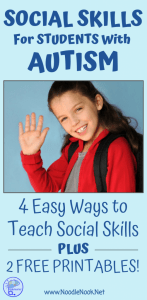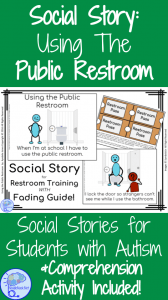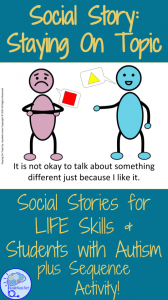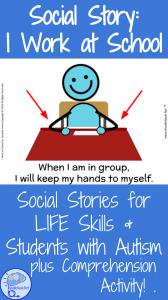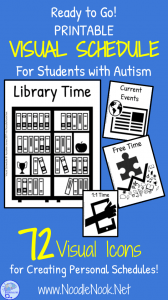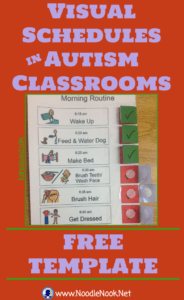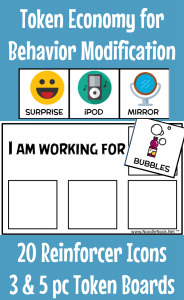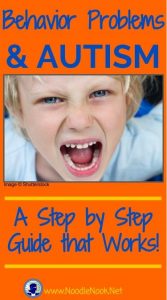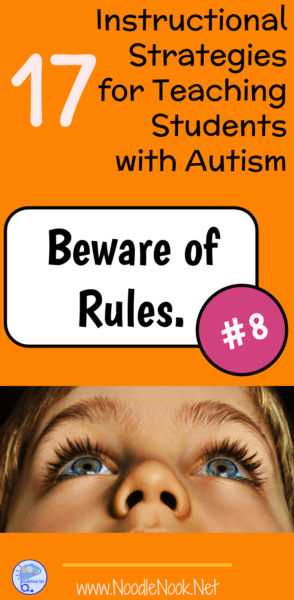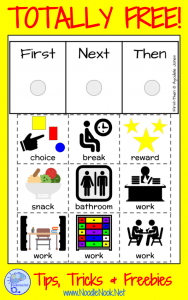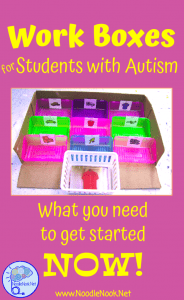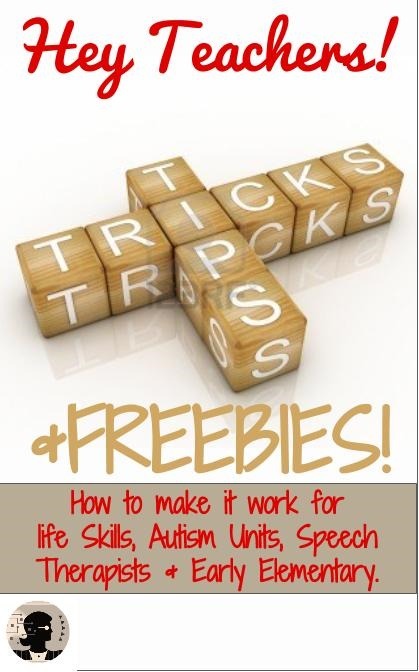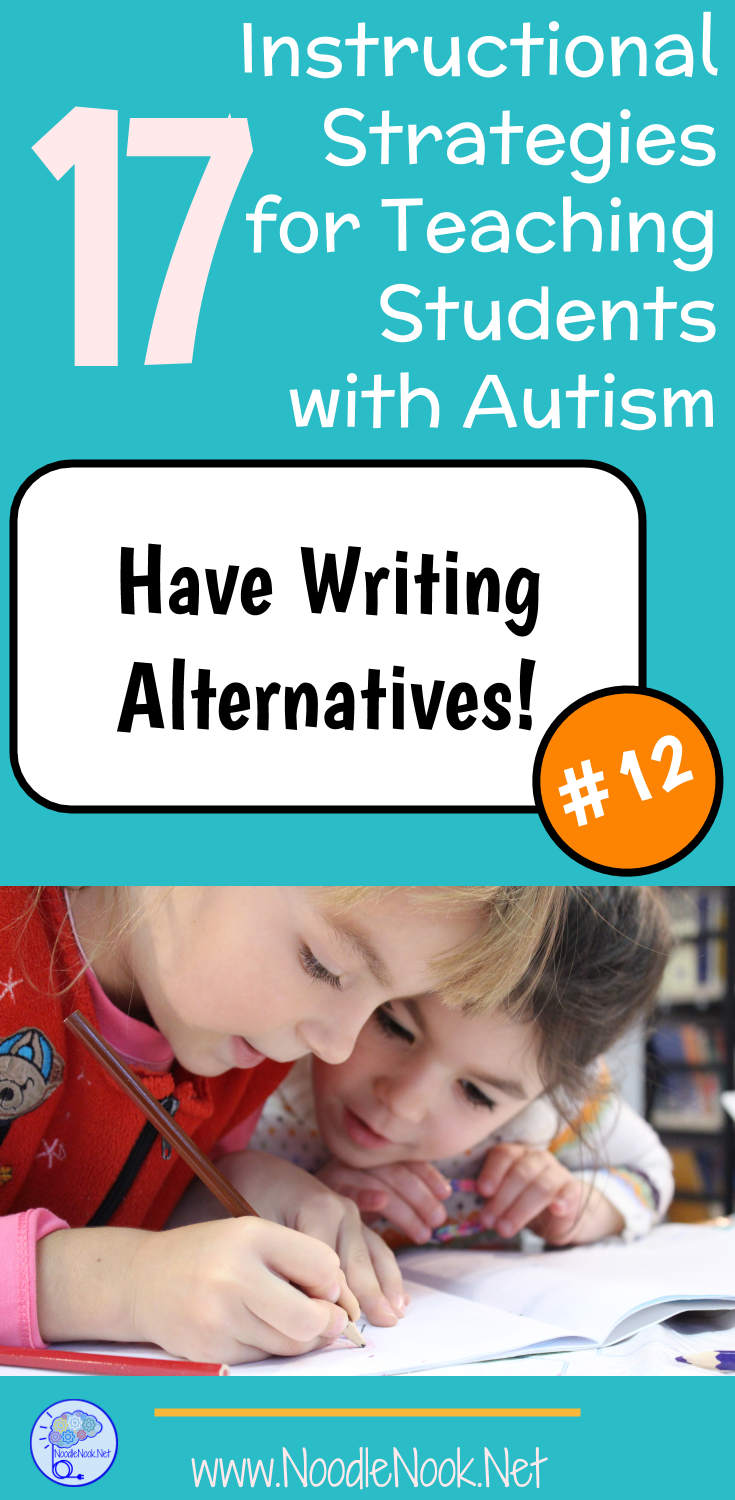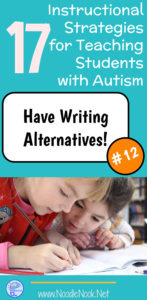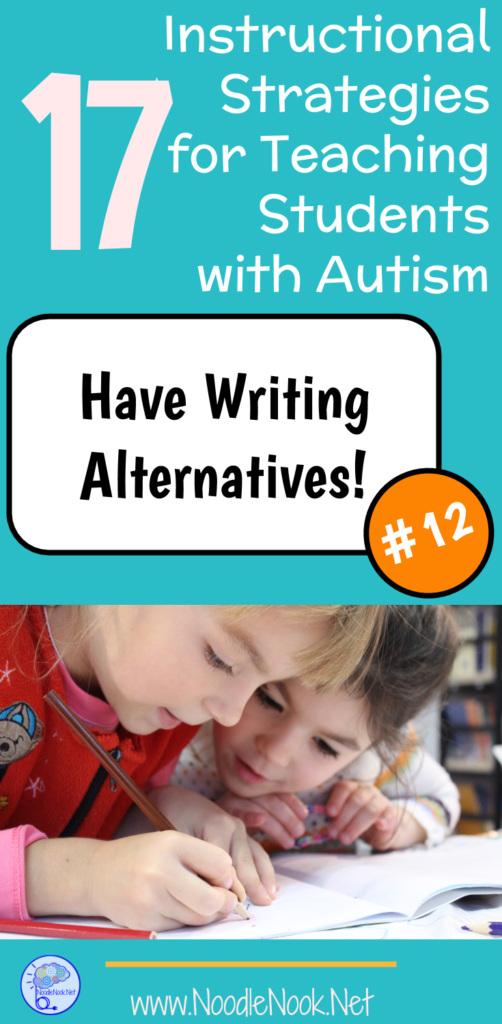Instructional Strategies for Students with Autism
I started in my first self-contained classroom mid semester… and it was tough. The routines and procedures are already written in stone and you have to come in and rock the boat. So what do you need? You need this simple list of instructional strategies for students with Autism.
#1 Model, Model, Model…
Hearing or reading how something is done versus doing it yourself are totally different learning experiences. When I need to learn a new skill, I look to YouTube to see someone show me how. Same thing here. Model what you want to see from a student so they have the benefit of a visual demonstration. The other thing you want to model, especially for students who are more functional but still struggle with social skills, is self-talk.
There is an entire narrative you talk through in your head as you decide on what to do. Example:
Me… in my head: “I’m hungry. It I eat too much now I won’t be hungry for dinner. I better have something light. What can I have. Maybe fruit would be good. What fruit is in the kitchen? Ah, an apple. That’s perfect.”
Basically we are modeling how we come to conclusions and make decisions (instead of acting on impulse or repetition of behaviors).
#2 Specifically Teach Social Skills
That needs to be part of your weekly routine and incorporated into your curriculum. That includes Role Playing where students can practice social scenarios so behaviors and scripts becomes habitual in the real world. You can also use social stories to have a narrative to work from. Want to read more about teaching social skills to students with Autism and Developmental Delays? Click Here!
#3 Independence is the Goal
Focus on skills like self-management, wait time, and turn-taking so you are consistently building independence. Remember, when our students age out of the K-12 educational system and move to adult services, they need to have established some level of independence… and the more the better.
I remember being in a classroom where a new teacher had concern about a student who was able to talk not participating in the lessons. I watched. The teacher asked a question, waited about 3-5 seconds for a response, restated the questions, waited another 3-5 seconds for a response… and then moved on to someone else.
“See,” she said. “He just won’t answer and I know he knows the answer and I know he can talk.”
I gave it a try. I asked him a question I knew he knew. And then I waited, making direct eye contact, and with an anticipatory face. He looked at me, looked away, looked back at me, looked away… and this went on for about 10-12 seconds (which is a really long time). He, finally, answered the question.
The teacher looked at me like I had cracked the code. It was just wait time. She looked at me perplexed- “I always give him wait time!” And that was true. She gave him wait time, but never waited for the answer. He just figured out if he never answered then she would go away. And she did.
Moral of the story- Don’t disable your students more by training them to be helpless. Always be working towards independence.
#4 Have Consistent Routines and Procedures
We are all creatures of habit, but students with Autism not only depend on them, they become dependent on them. That dependence is a great way to build in best practices (like time to work, time to transition, time to socialize), but can also increase a student’s ability to be independent by learning what to do when.
#5 Prepare for Changes
Be sure to front-load any changes in routine! That dependence on routines and procedures also means that when you change the routine or the normal procedure, you must, must, must either give some advanced notice of the change or specifically teach breaks in routine (like by teaching procedures for fire drills, pep rallies, and testing days). You may also want to teach the idea of -ish… things never happen at the exact second they were supposed to. When I go to the doctor for a 9am appointment I inevitably end up going back slightly before or after 9am. Teaching our students to be cool with a 5-10 minute swing helps a lot to prepare students for delays or being early.
#6 Know the Function
You MUST understand Functions of Behavior and identify the antecedents… so you can avoid meltdowns or tantrums. If you need more guidance on how to address problem behavior, read this article here. Always do your best not to walk into a behavior trap and set a student off accidentally- choose your battles. And do address behavior, but with a well thought out plan and according to the BIP. Here’s more on writing an effective BIP.
#7 Use Concrete Examples
And this also means avoiding idioms. A student may actually look outside for the animals when you say it’s raining cats and dogs. Literal thinkers can’t help it. But use this to your advantage by incorporating concrete examples into your instruction. If you are talking about counting by twos, set up some manipulatives to make that meaningful. Images, visuals, and tactile tools matter!
#8 Beware of Using ‘Rules’
Be Cautious of Using ‘Rules’… with your literal thinkers in mind, if you say the rule it to always raise your hand before using the bathroom, I may take that as it’s better to pee on myself while waiting for you to acknowledge my hand while out on the playground as opposed to tell someone or rush to the bathroom in time. That’s where the self-talk and -ish come into play.
I once had a student who I told could have his preferred activity for 10 minutes at break, which was at 10:45. He went back to work easily and I chalked up a ‘win’ for me. Suddenly, while he was working, he burst out into tears, began throwing all his stuff, and banging his head. After a long and violent 20 minutes, he was finally calm enough to talk with me. I asked questions to figure out what happened. Eventually I found out he was upset because he looked up and it was 10:47… He thought he had missed his break. Silly me- I set a rule and my concrete thinker wrote it in stone. Be cautious of rules.
#9 Include Successes
Include Successes in Your Work Cycle… because success breeds success. Think of the last time you played a video game, maybe Candy Crush just as an example. Think of the first level- totally easy, right? Well, that’s exactly the point. When you have a win, you’re motivated to keep on going and also predisposed to think you are going to be successful. Even when things get more challenging, you persevere because you have a history of success.
In the classroom, you have to build in opportunities for students to be and feel successful. Now this doesn’t mean you celebrate every mediocrity, but be sure there are plenty of positive learning experiences every day.
#10 Offer Choice
Offer Choice… and do it as often as possible. How many choices did you make this morning before you even got to work? I’m guessing a lot.
The average adult makes about 35,000 choices per day- and over 200 of those are just about food! Now think of some of your students- how many choices do they make a day? We decide when things happen, what a student will do, when and what they eat, and sometimes even what they will wear. With so much stripped away, we have to be very purposeful to build in choice whenever possible.
Even if it is a choice between two assignments, a student can decide which one to do first. Some Choice. Any Choice!
#11 Know Student Work Time
Be Aware of Work Time… and be sure to offer breaks between work tasks. That means match the amount of work time to a student’s stamina to avoid behaviors.
We all have that one student- you know who he is. No matter the activity you put in front of him, he always finishes in less than 5 minutes and then turns into a walking/talking/stimming disaster. But they are not the problem, we are. We have to plan for the amount of time they work. Plan for the work they need to fill the lesson time.
On the other end of that is a student who has to write their name on their paper and 75 minutes later still has not finished. We must be willing to end the activity when the activity time ends- not drag things into perpetuity because a student works slowly. Speed up, make modifications or accommodations, and help students learn about deadlines.
#12 Have Writing Alternatives
Implement Alternatives to Writing… to demonstrate learning and understanding. Our students struggle with writing in a traditional manner. I had a little boy in second grade who was a horrible writer. It was painful. Horribly painful. He was actually a poor reader and not the greatest at math. Whenever there was an assignment that required him to even have to hold a pencil it was a mess. Assessing him was hard as many assessments were given in a paper-pencil format and even when we modified the response mode, he never seemed that interested. Now, this was back in the pre-1:1 computing era. I did have an AlphaSmart for another student and tried it out with him one day. There was a prompt on the board. I asked him to try to write one word from the vocabulary list- I would be right back (he was the kind of kid who needed some space).
We scarcely got one or two words out of this kid. Three was a miracle. That day he wrote two sentences, more than 15 words, with proper capitalization, punctuation and spelling. And SPELLING!
Moral of this story: not everyone is a paper-pencil writer. Develop alternatives to writing.
#13 Have High Expectations
Have High Expectations… but be realistic. Nothing makes my skin crawl more than the phrase “My kids can’t do that, they’re too low.” *Sigh*
Always have high expectations.
[tweetthis remove_hidden_hashtags=”true”]Expecting a kid can only reach the ceiling, means never teaching them skills to reach for the stars.[/tweetthis]
#14 Generalize Skills
Always Work in Opportunities to Generalize Skills. Has this ever happened to you: you say ‘Hello, how are you today?’ to a student and they look at you, say ‘I’m fine, thank you. How are you?’ back, and use a normal volume and tone… and then they turn to a stranger and can’t even utter a ‘hi’? When we teach, we have to have chances for students to use what they are learning in a new environment or with different people.
#15 Pair Verbal with Visual
Pair Verbal Instructions with Visual Supports or Gestural Signals… and keep verbal directions to a minimum. Student with Autism have problems processing auditory information. When we only give directions orally, we are not presenting information in the preferred way. Pair oral directions with a visual support or a gesture to allow students who are struggling with processing auditory information to have another way to get it.
#16 Use Visual Supports
Use Visual Supports for Behavior and Routine Too… by using things like first-then charts, token economies, or work systems. Visual supports are so important with auditory processing delays- so if you are in a classroom with low-incidence disability students who you insist don’t need any visuals then you are discounting the hallmarks of their disability. They may not need visuals according to you, but they will benefit from them. Add them… now.
#17 Have Parent Relationships
Establish a Good Relationship Between Home and School… everyone is someone’s baby. The students you like and the students you like less- they are someone’s baby all the same. I always tell people that if I were the parent of special needs student, I would be the parent you hated. Why? Because I would be out there fighting for my child at every turn. No parent of a special needs student is a pain just to be a pain. They are out there to advocate for their baby, just like you would do. Be compassionate and establish a relationship with them- it makes your life easier in the long run.
Instructional Strategies for Students with Autism
If you can do this handful of strategies with your students with Autism you will find your life is easier and your students are more successful. Pin this infographic so you have for later… better yet, print a copy so you can have it in your classroom.
Now go forth and teach on!



